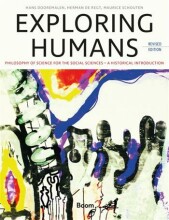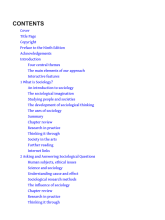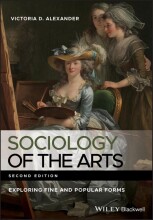Summary: Cultural And Creative Industries
- This + 400k other summaries
- A unique study and practice tool
- Never study anything twice again
- Get the grades you hope for
- 100% sure, 100% understanding
Read the summary and the most important questions on Cultural and Creative Industries
-
1 Week 1: Introduction
-
1.1.1 An overview of some changes - and the importance of continuity
This is a preview. There are 1 more flashcards available for chapter 1.1.1
Show more cards here -
To what does Hesmondhalgh (2019) refer to when he talks about "texts" in his book The Cultural Industries?
- The collective name for content and for cultural 'works' of all kinds.
- I.e., the films, recordings, boos, comics, images, magazines, newspapers and television programmes produced by the cultural industries.
- In other words, the products that the cultural industries produces.
- The collective name for content and for cultural 'works' of all kinds.
-
According to Hesmondhalgh (2019) the cultural industries have undergone some profound changes since 1980, as well as some things that remained consitent.What are the 3 most important points of continuity?
- Pre-internet industries remain (important).
- I.e., music, TV, publishing.
- The star system remains.
- CCI's as winner-takes-most markets.
- USA is still the primary producer of popular culture.
- Pre-internet industries remain (important).
-
1.1.3 Matters of definition
This is a preview. There are 1 more flashcards available for chapter 1.1.3
Show more cards here -
Hesmondhalgh (2019) discusses that nearly everything could be explained as being a "text". Can you explain how Hesmondhalgh (2019) proposes to distinguish texts from other products?
- A text (songs narratives, performances) tend to be heavy on meaning (and sometimes emotion), and light on functionality.
- I.e., Texts are created with communicative goals mainly in mind.
-
What defines a core cultural industry, according to Hesmondhalgh (2019), and what are the seven core cultural industries he delineates?
- Core cultural industries are centrally concerned with the industrial production and circulation of texts.
- The Core cultural industries are:
- Television and radio.
- Film industries.
- Music industries.
- Print and electronic publishing.
- Video and computer games.
- Advertising, marketing and public relations.
- Have a larger functional element than others.
- Web design.
- Core cultural industries are centrally concerned with the industrial production and circulation of texts.
-
According to Hesmondhalgh (2019) the core cultural industries are interconnected with each other, largely, because they compete with each other for the same resources. What are the four most significant resources?
- A limited pool of disposable consumer income.
- A limited pool of advertising revenue.
- A limited amount of consumption time.
- Skilled creative and technical labour.
- A limited pool of disposable consumer income.
-
Can you give a definition of what Hesmondhalgh (2019) terms "peripheral industries"?
Peripheral industries differ fromcore industries on 2 aspects:- They reach less people in
contemporary society and therefore have alesser cultural influence. - Their production of
texts are mainly based onsemi-industrial or non-industrial methods. - They are less involved in the
reproduction oftexts . - E.g.,
performing arts need to create the text live each time andreproduction is hard. - Examples of peripheral
industries are: Visual arts .- Performing
arts .
-
What are the 3 key neighbouring industries, with whom cultural industries are often in competition, collaboration with?
- Telecommunication industries.
- Consumer electronics industries.
- Information technology industries.
- Telecommunication industries.
-
Can you name the four borderline cases of industrial sectors that have a strong 'cultural' component but are not a core cultural industry and explain why they are excluded from the latter?
- Fashion.
- Higher degree of focus on functionality, although signification is important.
- Sport.
- Sport is fundamentally competitive while symbol making isn't.
- Design.
- While aesthetic appeal is important in many design contexts, it is not an essential or defining element.
- Social Media.
- While they make money out of advertising, like many cultural industry companies, social media companies produce little or no content themselves.
- Fashion.
-
What are, according to Hesmondhalgh (2019) the four common risks and their common solutions of the cultural industries?
- Products of high risks with lots of
failures . - Setting off misses against hits - building a repertoire.
- Formatting: stars, sequels, genres.
Tensions betweencreativity andcommerce .- Horizontal, vertical, and other forms of integrations.
Expensive toproduce ,inexpensive toreproduce (copy/print).- Control of creators vs control of distribution.
Non-rival goods; the need to createscarcity .- Artificial scarcity.
- Products of high risks with lots of
-
2 Week 2: Art and Commerce
-
2.1 Caves (2000) Economic Properties of Creative Activities
This is a preview. There are 7 more flashcards available for chapter 2.1
Show more cards here -
What are, according to Caves (2000), the seven basic economic properties of the Creative Industries that are specific to the Creative Industries and underpin their organization and structure?"
- Nobody Knows principle.
- Art for Art's Sake principle.
- Motley Crew (unusual mixed group) principle.
- Infinite Variety principle.
- A List/ B List principle.
- Time Flies Principle.
- Ars Longa principle.
- Nobody Knows principle.
- Higher grades + faster learning
- Never study anything twice
- 100% sure, 100% understanding
Topics related to Summary: Cultural And Creative Industries
-
Art and Commerce - Caves (2000) Economic Properties of Creative Activities
-
Art and Commerce - Kellner (2012): The Frankfurt School and the Creative Industry
-
Policy Perspectives - Oakley, K. (2006). Include us out—economic development and social policy in the creative industries
-
Policy Perspectives - Flew & Cunningham. (2010) Creative industries after the first decade of debate
-
Autonomy and Precarity
-
Gatekeepers - Negus (2002): The Work of Cultural Intermediaries and the Enduring Distance between Production and Consumption
-
Diversity and Inclusion
-
Reputation, Space, and Place - Lloyd (2002): Neo-bohemia: Art and neighborhood redevelopment in Chicago
































